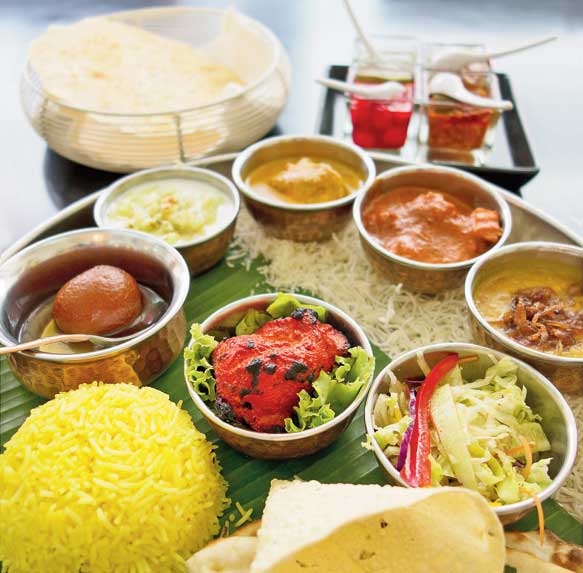Not so long ago, I was attending a culinary course in Europe and, on the last day of our classes, my batch was tasked with cooking something from their home countries. Although we were all enjoying the multitude of dishes we cooked and savoured every day, some of which were absolute best available anywhere, we all did jump at the opportunity to be able to showcase our cuisines and were quite excited.
We were all asked to submit the list of required ingredients, and the nonplussed gaze of the chef in charge of this, a burly American himself, should have been a giveaway. “How many dishes are you going to make?” he asked, to which, I replied matter of factly: “Uhm, one.” I was told something on these lines: “You need 16 ingredients to cook one dish, well, good luck with your Makhani, but the chief chef here likes to see all the ingredients ‘reach their true potential’.” I, of course, agreed, and went on to imagine the applause that I would undeniably have deserved after cooking what I thought to be among the best appreciated Indian dish anywhere on the globe — the quintessential Chicken Makhani.
The next day, while everyone quite enjoyed one another’s dishes, our head instructor seemed to be rather parsimonious in appreciating my dish, and I asked him why. In a thick Italian accent he said: “Well look chef, I had arranged some great wild tomatoes for your dish and was hoping that those would really shine through.” Deeply stressing each word he added: “But where are my tomatoes?” While the borderline despondency in his voice was unmissable, and it felt that he treasured each of his ingredients like all true chefs should. His next few words left a mark on me: “You see, one of the biggest mistakes that we all make is to believe that the more ingredients we use in a dish, the better it becomes, especially if the ingredients are of good quality, but that isn’t true for the most part. Restraint is key, whether in life or in cooking, and the knowledge of that balance is what finesse is all about.”
As ill-luck would have it, the first meal that I had after having returned to India was an assembly-line pizza and after having freshly trained in pizza making, I could feel there was something missing (or existing too much!) in the pizzas we normally have in India. While it can have two crusts, 12 toppings and four kinds of cheese… all in one pizza!... it does not have that delicious simplicity of the ones that I thought I could get used to, the three-ingredient Italian pizzas with a touch of finesse and a whole lot of “restraint”. Obviously we do get some excellent quality pizzas in India, comparable to the best anywhere, but the general belief is that “overloaded” is worth more than the frugally-topped; it is clearly not true, not to me anyway.

More the number of dishes on a thali, the more expensive and elaborate it is considered.
The role of ‘restraint’
If you really think about it, taste is a sum of all the restraints we put together in a dish. This can be in terms of ingredients — think of an extra vegetable, say a carrot, in chicken biryani — or the time of cooking, we know it is way easier to overcook a dish than to undercook it since the former requires knowledge while the latter requires restraint. While it is not easy to fathom the concept of practising restraint in Indian cuisine, with our average dishes containing at least seven ingredients, as per a report in The Washington Post, which also mentions that Indian cuisine is among the most ingredient-heavy cuisines, one that uses almost all basic ingredients available, anywhere in the world, in one form or the other.
While it is also true that the use of multiple ingredients does provide sophistication and a depth of flavours that Indian cuisine is so known for, it is also worth mentioning that often in many of our dishes it is impossible to distinguish or discern the various ingredients used while in Western food culture, by and large, there are “big” flavours, mostly on the back of the fewer ingredients used.
It would be imprudent for me to generalise this since food is a personal preference and is just too wide a subject to draw straight comparisons, but it is true that as Indians we have always celebrated the multitude of available ingredients. We normally associate more with better. Take the example of our thali-style meals. More the number of dishes on a thali, the more expensive and elaborate it is considered while in a typical Western menu, a meal would be considered better if the ingredients used are better in quality: A steak dinner will be good with a rump steak. To elevate it to the next level, we won’t actually add five more dishes to the meal but just replace the rump steak with a filet mignon, and it can be five times more expensive.

Vikas Kumar Telegraph picture
Culinary restraints
So there are various ways in which we can practise the concept of restraint towards making better food, let us examine a few.
Ingredients: This is a no-brainer and something I’ve harped on for a quarter of my article, it is important to understand the role of each ingredient in our dish and to eliminate the ones that are not really required. While this may sound complicated, it really is simple. In our kitchens we say, “One should not feel the salt in the food”. It doesn’t mean that we should put less salt, but just that it should not be “felt” in way of being less or more than required. Many cooks make the mistake of equating better food with more ingredients and this is mostly not true. So unless you’re making a shukto, which I did a while back and used 10 different vegetables (it did taste delicious!), or something genuinely traditional, try and use only the ingredients that would shine through the dish. Believe me, it works.
Time: The quest of “safety” while cooking, the fear of serving undercooked food often leads us into overcooking. How often have we wished that we cooked our rice or pasta a few minutes less or taken that cake out of the oven just when the buzzer went off without second-guessing the “skewer test”. The fact is that overcooking food is one of the main reasons we do not realise the true potential of many of our foods. While experience alone can provide enough confidence to be able to correctly identify the doneness of foods, it is true that through the practise of restraint and calculated risk-taking can we avoid overcooking and enhance our culinary and nutritional experiences. On the face of it, this seems like a rather innocuous suggestion but if I had a quarter for every time I gave an extra minute or 10 to that steak, cheesecake or gulab jamun, I’d be substantially opulent today.
Fiddling: Another mistake that novice as well as experienced cooks make is that we don’t “let it be”. While overcooking is a common mistake as it is, over handling of food is another area that needs work. While it is an inherent impulse to poke, flip or stir while we see the food cooking before us, in my experience, there is a certain amount of restraint required in not “moving” our foods too much while it’s cooking. Sure it’s tempting, daunting even, to not check the food constantly and having them cook more or lesser than required, but most times, and this would come with experience, it just makes sense to let the food and the heat do their thing.
Portion control: This is one of my favourite topics when it comes to practising restraint while cooking or serving food. Traditionally, in Indian homes, including mine, the lady of the house always cooks for more people than present in the house to account for any unexpected visitors. The fact is we serve our portions way bigger than required. This is mostly because of the tradition of Indians eating relatively bigger meals since they don’t generally snack between meals but also because larger portions are considered to be a symbol of affluence, care and motherly love.
I wrote a column earlier elaborating how portion control alone can save the world a significantly large amount of usable food wastage and can help us keep healthier and perhaps spend less. But it is also true that various studies have been conducted that prove that smaller portions taste better and satisfy more. While the “law of diminishing returns” (our professor in college actually used to explain this to us by citing the example of satisfaction we would experience if we had 10 rasgullas and if it would be the same for the first and the 10th) is all too well-known, there is a study by Stanford University that has thrown some light on what is known as “sensory-specific satiety”. Basically, in the research, it was found out that each bit of food tastes less pleasant than the one before it and that we are much likely to enjoy smaller portions of foods than larger. So there you go, while it might still be considered subpar hospitality if you served a couple of pakoras with the tea to your guests rather than a mound of it, make no mistake, those will taste better, as we now know.
Vikas Kumar is the executive chef of Flurys. You can reach him at vkumar@flurys.com

Poached Pear, a two-ingredient dessert
While we are at the topic of “restraint” in cooking, and I have been a long-time proponent of using our food ingredients judiciously, here I present a beautiful dessert that will test all your restraint skills but the end result will be delicate, full of flavour and finesse.
- Ingredients
- 4 fresh pears (peeled whole)
- 300ml good quality port/red wine
Method
Boil the red wine/port and simmer till it loses its acidity and turns sweeter. A little sugar can be added if the wines are too dry. If you like spices, add some cinnamon, cloves and orange peel.
Lower the peeled pears in the wine, control the heat (restraint, remember?!) and let it simmer covered for 20-25 minutes. Do not overcook the pears, they should still be slightly hard but tender. Take the pears out of the syrup and keep aside to cool, reduce the remaining syrup till thick.
Serve the pears at room temperature, one a portion, sparingly spooning the wine syrup over it. If you really want to go for it, serve a dollop of whipped cream, mascarpone cheese or good quality vanilla ice cream.










